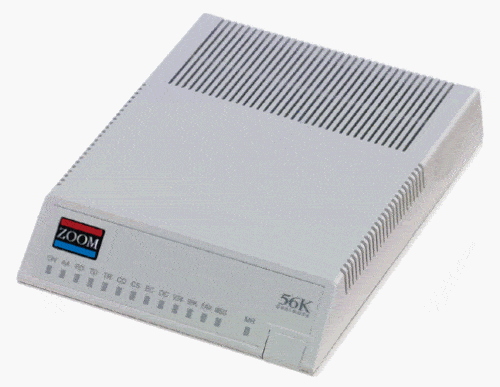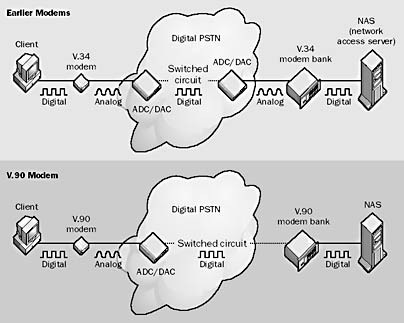Definition of V.90 Modem Serial Transmission in Network Encyclopedia.
What is V.90?
V.90 is a serial transmission standard for high-speed communication using modems. V.90, which is part of the V series standards developed by the International Telecommunication Union (ITU), evolved from the earlier x2 modem technology developed by U.S. Robotics (later bought by 3Com) and the K56flex modem technology developed by Rockwell.

V.90 claims to support modem communication at a speed of 56 Kbps, but this is limited by several factors:
- The top speed of 56 Kbps is achievable only for downstream traffic from the Internet service provider (ISP) via the telco central office (CO) to the customer premises. This downstream speed is achieved by using a pure digital downstream connection at the telco side, thus eliminating the quantization error that occurs during analog-to-digital conversion (ADC). The digital data path is actually 64 Kbps throughout the Public Switched Telephone Network (PSTN), but due to digital-to-analog conversion (DAC) at the CO where the digital PSTN backbone is switched to the analog local loop, information loss results, which reduces the possible speed to 56 Kbps.
- The actual top downstream speed for V.90 is only 53 Kbps. This is because of Federal Communications Commission (FCC) regulations on communication over telephone lines, which mandate the maximum signal power that can be transmitted over the PSTN to prevent crosstalk from degrading signal quality.
- The actual top downstream speed is less if line distances exceed 3.5 miles or if line conditions are poor. Typical downstream speeds are 40 to 50 Kbps. V.90 includes a mechanism whereby the client modem issues a request for a test tone during negotiation, which is used to gauge the line quality to determine the optimal downstream transmission speed.
- Upstream speed for V.90 is limited to 33.6 Kbps and operates according to the older V.34b standard.
- V.90 is possible only on telephone networks that have only one analog segment in the communication path (the local loop at the subscriber end) instead of two analog segments (at both the subscriber and ISP/CO ends).

V.90 Simultaneous transmission of data
V.90 replaced two vendor standards (K56flex and X2) and was designed to allow modems from both prior standards to be flash upgraded to support it. It was developed between March 1998 and February 1999. It is also known as V.Last as it was anticipated to be the last standard for modems operating near the channel capacity of POTS lines to be developed. V.90 is generally used in concert with the V.42bis compression standard. A follow-on standard, V.92, was developed later in 1999 to replace V.90.